By: Kimmy Tanchay
PROJECT TITLE: Plastic Paradise

PROJECT STATEMENT:
“Our Oceans Are Turning into Plastic… Are We?”
-Susan Casey
Globally, plastic pollution is a problem. However, this is especially so in the Philippines, my home country. Despite being heavily reliant on the ocean as a source of tourism, livelihood and leisure, the Philippines is the 3rd largest ocean plastic polluter in the world. Hence, this piece attempts to visually highlight the scary reality that if we continue on as we currently do, there will be more plastic in the ocean than fish by 2050.
RESEARCH
The very first assignment for our class really impacted my choices on what materials I wanted to include. That assignment made me really realise what type and how much trash I create. Hence, I limited myself to using materials that only I collected as a personal challenge for me to finally be able to recycle my trash that I normally just throw out. From this, I found out much of my trash surrounds plastic bags from grocery shopping, bubble wrap from Taobao orders and fruit styrofoam.
I was really excited to work with bubble wrap as I really like the interesting texture and look that it could give to a wearable piece — in a way it could even replicate sheer clothing. Through research and finding inspiration online, I decided this sheerness and translucency of bubble wrap was essential as I wanted to explore the symbolism of the bubble wrap representing water and the ocean. With this, I was then going to stick a multitude of different kinds of trash onto to dress to replicate the trash floating in our oceans.

bubble wrap just seems really cool to me
that i can imagine someone wearing
this as street style

inspiration; fruit styrofoam textures
Thanks to the workshops, I learned how to hot press and use the sewing machine. To get a sense of how I can fuse and mould these materials together, I did some experimenting on sewing and hot pressing various plastics, bubble wraps and whatever materials I can find. Although very useful to attach fabrics together, the sewing machine was not as efficient when done on plastics and bubble wrap. Even with adjusted settings, the thread was not delicate enough and broke large holes especially with thinner plastic and bubble wrap. Seeing as I’m mostly be working with bubble wrap as the central material of my piece, I decided that I would have to use hot press as my main way of fusing and attaching my materials together.
SIGNIFICANCE
For my message and significance of my piece, I really wanted to include the Philippines as I have a deep connection and love to it. Just from quick Google searches, it was very clear ocean plastic pollution is a huge problem, especially in a developing country with more than seven thousand islands. These problems stem from a multitude of problems including lack of education, regulation, poverty and methods of proper trash disposal.



First of all, through this piece, I hope to shine light upon this issue; even though there are a plethora of articles online stating this problem, the Philippine government, schools and local barangays have not done or changed very much at all in order to help solve this issue. The ocean has always been a central part of the Philippines’ landscape and culture, hence there should be more urgency in tackling this problem.
If my project were replicable and scalable, I hope to show to the community how trash can easily be broken apart, fused and repurposed to be a variety of different things; how bubble wrap can become a dress and plastic bags become sea creatures. I know and experienced how resourceful and extremely creative Filipinos are and I’m sure with the right tools and skills, they will be able to make use of trash to create a multitude of different things.
DESIGN & PRODUCTION
In my midterm proposal post, I outlined how I wanted to create a basic top that was simple and minimalistic as I initially thought the piece had to look ‘sellable’ and also, I wasn’t sure of my trash designing abilities. However after I started the process of making my piece, I found that it diverged in some aspects to my original idea. After I was sure I wanted to centre my piece around ocean pollution, I decided to create a dress instead as it gave me more working space to include more decoration to get my message across.

my initial midterm proposal
I started off making my piece by measuring out and deciding what silhouette I wanted for the dress. I decided to make the silhouette quite loose and baggy to emulate a plastic bag. After drawing out the basic alignments I cut out the beginnings of the dress. However, since I never designed clothes before, I miscalculated the measurements of the bubble wrap when I cut out the dress, leaving me with less fabric than I needed. At this stage, I really wanted to use the sewing machine as then I would be able to have cute patterns and stitches. However, when I tested sewing a bit of bubble wrap, it simply was too delicate for thread and needles. This meant that I had to hot press the bubble wrap together, which meant the material became a more fragile and more prone to tearing.
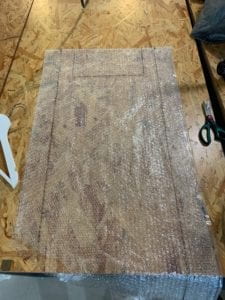
drawing the outline shape of the dress

realised i miscalculated and
having to hot press the
bubble wrap back together again
When I first thought of my design, I wanted to use bubble wrap stuck onto blue clear plastics to symbolise the blue ocean. However, from just hot pressing the bubble wrap together, I decided to skip out this as I was too scared the material of would be too delicate from too much hot pressing. Instead, I used the blue as a contrast colour, lining the bottom and tops of the dress to create a clearer silhouette of the design as the just bubble wrap was quite hard to see.
.
readjusted the straps
to fit the mannequin
with more hot pressing
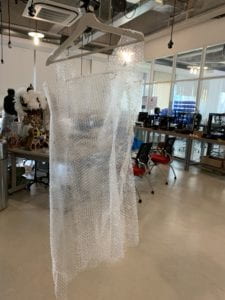
basic shape of dress
Once this was done, I moved onto making ‘frills’ using fruit styrofoam to decorate the ends of my dress. I thought these would not only symbolise the coral reefs but also add colour, to an otherwise plain clear dress. I initially thought the hot glue gun would be the best means of attaching the styrofoams together. However, that proved not to be true as it basically started disintegrating and melting just from touching the hot glue. Hence, I went back and hot pressed them together but in a lower temperature as it was even more fragile than the bubble wrap.

adding colour contrasts to an otherwise
plain bubble wrap dress

bubble wrap dress with added on styrofoam
to mimic frills and ocean coral
Collecting the most colourful plastic bags I had, I then started cutting some of them up to make the sea creatures that would go on the dress. From these coloured bags, I formed fishes, a sea turtle, jellyfish and a starfish. At first I simply tried to mould them into their shape with tape or string, however they still very flimsy and puffy. Therefore, I had to go back to the hot press to try to flatten them and mould them even further so their shape would stay in place. As they were thick layers of plastic, I knew that hot pressing these were not an option and so I resorted to the hot glue gun. After scrambling to get the glue on the plastic as fast as possible to avoid melting, my piece was finished.
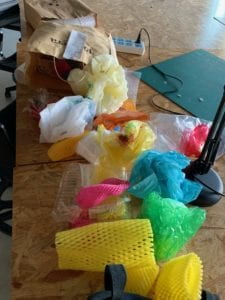 my own trash i
my own trash i
collected over 2 weeks

plastic bag shaped as fish using string,
tape and hot pressing
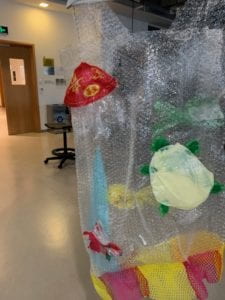
plastic jellyfish, sea turtle and starfish
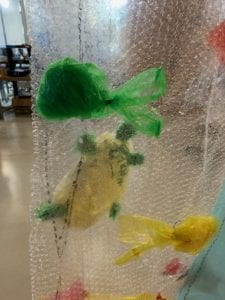
closer view of the dress
CONCLUSIONS:
The wrap-up of your conclusion delivers your final say on the issues you have raised previously, demonstrates the importance of your ideas, and insightfully synthesizes your thoughts about key elements of the project experience.
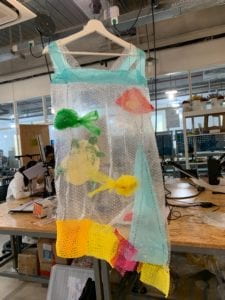
the finished piece
In the end, I think my piece somewhat reflected the goals of my project. I wanted to shed light on the problem of plastic pollution as this is a problem that is very relevant to the Philippines. With the use of blue colours and transparency of bubble wrap, plastic sea creatures and fruit styrofoam corals, I wanted to create a picturesque imagery of the ocean and its natural beauty whilst emphasising on the reality of what will happen if we continue to neglect our oceans the way we currently do.
Nonetheless, I experienced a fair number of difficulties with this project. As I’ve never designed clothes or upcycled trash before, everything was very new and experimental. This meant there were several aspects that I thought could have gone better such as more creative, adventurous design and a more put-together finish. I would have also like to have included the Philippines more in the actual design and not just the inspiration for my piece. Be that as it may, for a first project, I was satisfied with the results and excited for our next project or even try to do one on my own.
From this project, I learned a lot of new skills, utilised creativity and became more aware of plastic pollution in my own country. When we see daunting news articles and depressing pictures of trash pollution, it often makes us feel totally powerless as we believe only governments and powerful people can actually tackle this problem. However, from doing this project and challenging myself to make something artistic out of trash, it reminded me of the importance of individual effect and how significant that is, no matter how small.
Leave a Reply